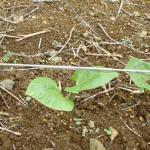Growing Beans - climbing, also Pole beans, Runner beans, Scarlet Runners
Phaseolus vulgaris, Phaseolus coccineus : Fabaceae / the pea or legume family
| Jan | Feb | Mar | Apr | May | Jun | Jul | Aug | Sep | Oct | Nov | Dec |
|---|---|---|---|---|---|---|---|---|---|---|---|
| P |
(Best months for growing Beans - climbing in USA - Zone 5a regions)
- P = Sow seed
- Easy to grow. Sow in garden. Sow seed at a depth approximately three times the diameter of the seed. Best planted at soil temperatures between 61°F and 86°F.
- Space plants: 4 - 8 inches apart
- Harvest in 9-11 weeks.
- Compatible with (can grow beside): Sweetcorn, spinach, lettuce, summer savory, dill, carrots, brassicas, beets, radish, strawberry, cucumbers, zucchini, tagates minuta (wild marigold)
- Avoid growing close to: Alliums (Chives, leek, garlic, onions), Florence fennel
Grow beans up fences, trellis, sweet corn, trees. Almost anywhere can be 'vertically productive'.
Keep well watered and pick regularly to encourage new flowers. Watch out for snails, as they will eat through the stems near ground level, and will completely eat newly sprouted beans. If you have nice new beans plants one day, and none the next, then it is probably slugs or snails.
Culinary hints - cooking and eating Beans - climbing
Use young in salads - blanch and cool. Will freeze well.



Your comments and tips